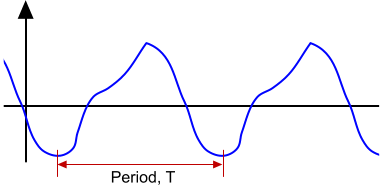Harmonic Balance
Some unsteady flows have a regularly repeating flow pattern, that is, they are time-periodic. Consider the flow from a fan blade passing across the entrance to a duct. Measurements of the instantaneous flow just within the duct would show a regularly repeating pattern. If the flow disturbances are sufficiently large, and propagate to the end of the duct, measurements of the unsteady flow at any point within the duct show repeating patterns. Such time-periodic patterns can be expressed using Fourier series.
Fourier series are series of cosine and sine terms that when taken together, reproduce a periodic function.

This periodic function, which is also known as a trigonometric series, can be written in simple form as:
The Simcenter STAR-CCM+ harmonic balance method is a mixed frequency/time domain technique for computational fluid dynamics. It enables the efficient calculation of time periodic flows. The unsteady solution is stored at a small number of fixed time levels (solution snapshots) over one time period of the unsteady flow in a single blade passage in each blade row; thus the solution is periodic by construction. The individual time levels are coupled to one another through a spectral operator representing the time derivative term in the Navier-Stokes equation, and at the boundaries of the computational domain through the application of periodic and nonreflecting boundary conditions.
Applications
The harmonic balance method allows for the rapid computation of unsteady flow solutions that are periodic in time. As a result, this method is useful for a wide variety of applications, including:
- Turbomachinery
- Tonal aeroacoustics
- Flutter and forced response
- Rotorcraft
In addition to quickly computing the periodic unsteady solution, the harmonic balance method can also account for inter-blade phase angle effects. This additional benefit means the harmonic balance method is well-suited for turbomachinery simulation. With the harmonic balance method, it is possible to represent how the solution varies from one blade to the next within a given row of a turbomachine while only meshing a single blade in that row. The need to mesh only one blade in each row dramatically reduces computational cost.
Benefits
The main benefit of the Harmonic Balance method is that you can solve unsteady flow problems using steady flow solver techniques. This means that the method is often faster than conventional time-accurate time-marching approaches.
Limitations
The method is designed to work with temporally periodic flows, or even some “nearly” periodic flows. It is not suited for transient problems that are non-periodic in time.
Currently, K-Epsilon, K-Omega, and Spalart-Allmaras turbulence models are available for use with Harmonic Balance. However, the setup and use of these turbulence models are identical to how the models would be used with conventional unsteady calculations.
The porous baffle, fan, and fully developed interfaces are not available with Harmonic Balance.
Working with the Harmonic Balance Method in Simcenter STAR-CCM+
The following sections provide information on the Harmonic Balance method in Simcenter STAR-CCM+.